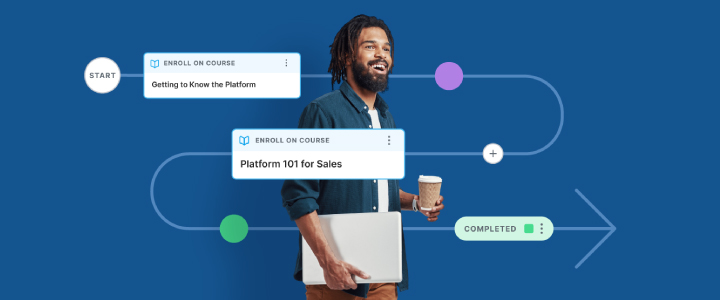
5 min reading time
VILT: Why Modern Businesses Are Making The Move To Virtual Learning
Over the last couple of years, we’ve noticed a shift.
Many businesses are embracing virtual elements in their learning strategies, with virtual instructor-led training or VILT fast becoming the de facto method for delivering training to learners, wherever they’re located, in a more efficient, scalable way. And, it’s obvious to see why.
Be it onboarding your new hires, showcasing your products to customers, or engaging partners and members, VILT is a powerful way to connect with your learning audience.
So, whether you’re taking the first step into the VILT world or if you’re looking to level up your current training, this guide dives into the benefits, shares the delivery options, and provides actionable tips for how your organization can succeed with your own VILT programs.
What is VILT?
First things first, if you’re new to VILT, you may be asking, “What is VILT, anyway?”. We think this definition by Training Industry sums it up pretty well:
“Virtual instructor-led training (VILT) refers to training that is delivered in a virtual or simulated environment, or when instructor and learner are in separate locations. Virtual instruction environments are designed to simulate the traditional classroom or learning experience.”
The chances are that you’ve likely taken part in VILT and you may not have even known it. Perhaps it was a webinar over Zoom or even a tutorial on YouTube; that’s all VILT.
Benefits of VILT
At Learnupon, we’ve seen the value of Live Learning first-hand through our customers. No matter who you’re training, it has big advantages for both learners, learning teams, and businesses. Here are some of the top ones.
Increase learner engagement
The big draw for VILT is the impact it has on our learner’s success. In fact, research from the NeuroLeadership Institute found that a successful virtual learning program is a whopping 600% more likely to lead to learner action.
The reason why? We believe it’s the personal touch. With VILT, your learners have a guide, talking to them (and maybe even interacting with them if it’s live).
The one asterisk is that in order to achieve that level of success, learning teams need to understand the unique features and challenges presented by a virtual environment. (We offer some recommendations and best practices below.)
Improve flexibility
For both learners and learning teams, VILT offers an increased level of flexibility – something that’s a necessity in the modern business world.
With more and more employees working remotely, or customers and partners located halfway around the globe, it no longer makes sense to organize in-person learning at a certain place and time. Instead, with VILT, your learner can be sitting at their kitchen table in New York, while an instructor is in the office in London training them online. It’s freedom.
Save time, money, and resources
Let’s face it, in-person learning is costly. Location, travel, instructors – with many learning teams already stretched thin, it’s a lot of energy that you might not be able to afford. With virtual-led training, things like travel times are reduced or eliminated altogether, employees don’t have to miss entire days of work, and costs are significantly reduced.
How to deliver VILT : Synchronous vs. asynchronous learning
When it comes to VILT, there’s two ways to deliver it: asynchronous and synchronous.
Most learners are already comfortable with both of these as the average person’s life consists of a combination of live calls or webinars (synchronous), emails (asynchronous), and chat (both synchronous and asynchronous).
Choosing between the two models isn’t necessarily an either/or calculation, and we recommend considering whichever blended learning model best meets the needs of your learners. That being said, let’s briefly touch on the benefits and requirements of both options:
Synchronous VILT
- Learners can still feel the personal touch of direct communication with an instructor, and receive answers to their questions in real time.
- Learning can be social or include games, since everyone is participating at the same time.
- Synchronous VILT requires a learning solution that integrates with a platform like Zoom or Microsoft Teams.
Asynchronous VILT
- Learners can control their own learning journey.
- Logistical challenges like time zones, team members who are out of office, and so on, are not a consideration.
- Asynchronous VILT requires a learning solution that supports on-demand video playback, and an organized interface that is easy to navigate independently.
Top tips for delivering VILT
Maximizing the benefits of VILT requires a strategy that makes the most of a virtual learning environment. Learning teams should resist the temptation to simply copy and paste in-person learning, and instead lean into the unique benefits and features of virtual instructor-led training. We recommend starting with these three tips:
1. Choose a VILT-friendly learning solution
It’s critical to choose a learning platform that was designed with virtual instructor-led training top of mind. That means offering features that support both synchronous and asynchronous learning, or whatever combination best aligns with the needs of your learners.
Modern learning platforms also offer time-saving automation that reduces duplicative work and connects with your company’s preferred webinar and communication tools. The solution should simplify the management and organization requirements of training too, with the ability to track enrollment, take attendance, and collect training data.
2. Put the learner first
It might seem simple, but one of the easiest ways to improve learner engagement is to simply ask, “How could I make this more engaging if I were the learner?”
This learner-first approach is always important, but especially when designing a virtual instructor-led training, since the virtual model can introduce some natural challenges to maintaining the attention of learners.
For example, don’t just offer a one-sided live session where the instructor talks for 60 minutes straight. Would it be better to break that content into four sections that are separated by an interactive exercise? As always, we recommend an iterative approach to increasing learner engagement. Design a training, test the results, refine, and repeat.
3. Recycle content when appropriate
Combining synchronous and asynchronous virtual-led training brings another benefit beyond learner engagement: the ability to repurpose content.
A session recording can be edited into smaller parts and included in a review module, or baked into a future training on the same subject. Once again, resist the urge to simply repurpose the entire recording top to bottom, but conversely don’t feel required to reinvent the wheel for every training.
The increased flexibility offered by VILT isn’t just for learners; it applies to learning teams as well.
Including VILT in your learning strategy
With so many upsides to virtual instructor-led training, there’s never been a better time to incorporate VILT into your training toolbox. If you choose a learning solution that supports VILT, and work to strategically design and refine a VILT-friendly program, you’ll unlock a host of benefits like increased learner engagement, improved flexibility, reduced cost, and much more.
Chat with our team today to find out how easy it is to start delivering VILT.



